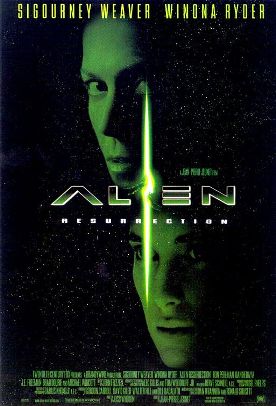Alien Resurrection
(Reviewed December 1, 1997)
|
| Rating: |

|
|
|
Order this DVD or Blu-ray through Amazon.com
|
The movies of the Alien series have always had as subtext the feminist view of abortion, but never more so than the latest, called Alien Resurrection, which comes to us from Jean-Pierre Jeunet. Jeunet was co-director of the very weird French films Delicatessen and City of Lost Children, and this looks a lot like both of them. Yet for all its French ambiance, its mythic force derives from its imagery of women forced into subjugation by the things growing inside them—things which take over their lives completely and will ultimately kill them. The dragon-slaying hero is the new, omnicompetent woman invented by Hollywood—in this case Ellen Ripley (Sigourney Weaver) who has triumphed even over death through the miracle of cloning—and the dragon is her baby.
Ripley not only kills dragon-babies, she also effortlessly beats back the menacing male sexuality of Ron Perlman and Michael Wincott. She stronger and quicker than they are, and she's better at basketball too. Talk about hitting a guy where it hurts! Even her blood is an offensive weapon, since it boils like sulphuric acid whenever she cuts herself and a drop spill anywhere but on her. In the film's climactic scene she makes especially effective use of this quality to dispose of a giant, toothy alien fetus who regards her as its mother. After nuzzling with the horrible thing and showing apparently maternal feelings toward it (on this point she is always ambiguous, identifying herself as “its mother” at one moment and shooting it at the next), she flings a drop of her blood at the tiny window (a window?) of the spaceship, puncturing a small hole in it. The monster is then sucked through the hole in disgusting ribbons of flesh and blood.
The imagery of abortion is unmistakable. As the creature is cut to pieces and evacuated into space, Ripley whispers “I'm sorry” to it. Obviously not sorry enough to sacrifice not only her own life but also that of her lesbian love interest, a robot played by Winona Ryder. The robot has already taken a bullet in the chest without ill effect, so it is not clear what Ripley thinks will happen to her as she grapples with the monster-fetus. But presumably even robots must be saved from the nightmare of motherhood. As the film ends, she and her beloved droid can breathe the free air of earth as we see the spaceship re-entering the atmosphere just at sunset amid pastel clouds. What a brave new world there is here to enjoy, unencumbered by the burden of nature.
The robot, programmed to save humanity, is the good guy and shows delicate feelings about Ripley—though obviously not her spawn. When Ripley finds out that it is a robot (because, unlike the fetuses, when blasted with futuristic weapons it doesn't die), she says: “I should have known. No human could be that humane.” Later, as they fight the monster-fetuses, Ripley asks the robot: “Why do you care?”
“I was programmed to.”
The bad guys are the mad scientists at the space station. Their attempts to bring the monsters to birth and “tame” them for human purposes seen to be—rather cheekily given that it is the abortionists who are accused of interfering with nature—a Promethian conceit. In outer space, at least, it is those who would preserve the monsters alive who are the Frankensteins. In one scene, Ripley leads her little band of smugglers and criminals into the room where the scientists keep their “cryo-tubes” containing the monstrous outcomes of their unspecified experiments. Looking like foetuses in various stages of development, they are meant to be seen as horrible mutants. One is alive and in terrible pain. It whispers to Ripley, “Kill me!” Ripley takes her flame-thrower and incinerates her. Then she incinerates all the rest of the mutants in their tubes.
Johner (Perlman) comments: “What's the big deal, man? A f***ing waste of ammo. Must be a chick thing.”
If he only knew! 
[Top][Back]
|



